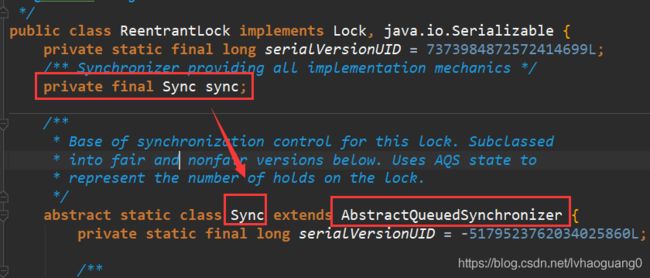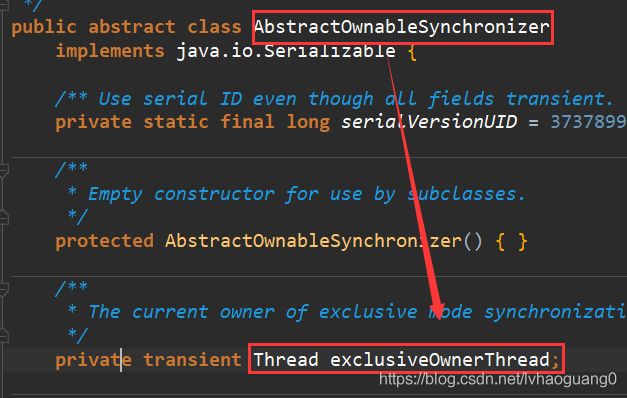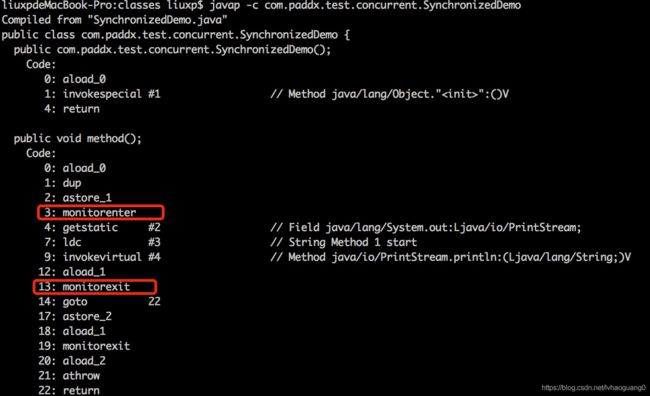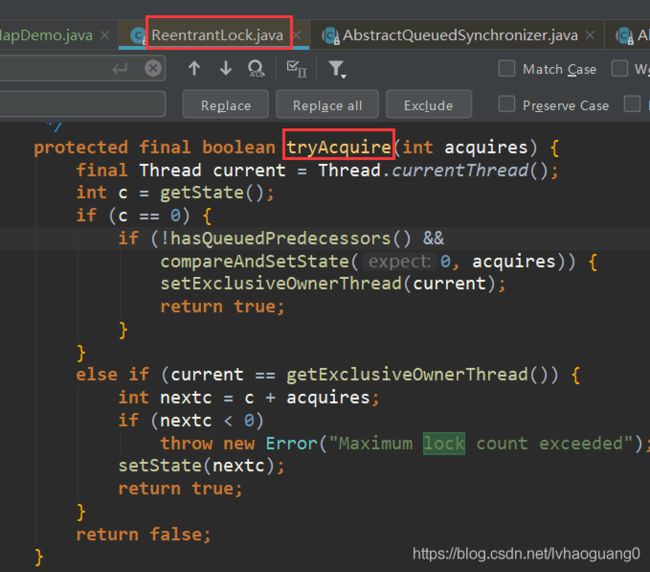- 【java】怎么理解不同对象实例的对象锁是互不干扰的
晨春计
Androidjava
在Java中,synchronized关键字用于实现线程同步,它可以作用于实例方法、静态方法以及代码块。当synchronized应用于实例方法或实例变量时,它创建的是一个对象锁,这个锁是与特定的对象实例关联的。因此,每个对象实例都有其自己的锁。这里的关键点在于,对象锁是绑定到特定对象实例上的。这意味着对于不同的对象实例,即使它们属于同一个类,它们各自拥有独立的对象锁。当一个线程获取了一个对象实例
- Rides实现分布式锁,保障数据一致性,Redisson分布式事务处理
朱杰jjj
缓存分布式
分布式环境下分布式锁有三种方式:基于数据库分布式锁基于Redis分布式锁基于zk分布式锁本帖只介绍Redis分布式锁为什么需要用到分布式锁?在单机环境下一个服务中多个线程对同一个事物或数据资源进行操作时,可以通过添加加锁方式(synchronized和lock)来解决数据一致性的问题。但是如果出现多个服务的情况下,这时候我们在通过synchronized和lock的方式来加锁会出现问题,因为多个服
- synchronized锁升级过程
liang8999
javajvm开发语言
一、synchronized锁加到什么地方synchronized上锁,其实锁信息是加在对象头中的markdown,对象中的前四个字节表示markdown;markdown还记录了对象的gc、hashcode信息注意:markdown结构与jvm虚拟机的实现有关,I)32位Hotspot虚拟机markdown结构如下:II)64位Hotspot虚拟机的markdown结构如下:二、synchron
- Java 入门基础篇05 - Java的关键字
仔仔 v1.0
Java基础java开发语言intellij-idea
什么是关键字?就是被java语言赋予特殊含义的单词。关键字的特点组成关键的字母都是小写。常见关键字class,public,static,void.....。关键字注意事项goto和const是java语言的保留字,关键字在IDEA编译器中有明确的颜色变化。关键字列表ABSTRACTCONTINUEFORNEWSWITCHassertdefaultgotopackagesynchronizedbo
- Java基础 -- 05反射reflect
mmlz00
Java基础Java基础反射reflectProxy动态代理
目录引序说不通1:注解说不通2:匿名内部类说不通3:动态代理反射:反射定义强调:类对象又强调:static类静态成员再三强调:synchronized修饰符类对象:知晓类结构类结构之:内部成员内部成员--构造函数内部成员--数据成员内部成员--方法成员静态代理:动态代理:反射+注解反射+泛型+注解getGenericSuperclass()用法引序引序:开始反射概念学习之前,先来段引序。请牢记:计
- 锁之synchronized 与volatile lock的异同
追梦的鱼儿
java锁synchronizedvolatileLock
目录synchronized特性用法使用场景synchronized的优缺点优点缺点volatile特性用法使用场景Lock特性用法使用场景总结相同点不同点synchronized关键字是Java提供的用于解决并发编程中数据一致性问题的重要工具。它通过锁机制确保在同一时刻只有一个线程能够执行被同步的方法或代码块,从而实现互斥访问。尽管synchronized使用简单且可靠,但在高并发场景下可能会带
- synchronized锁状态和底层实现
码了三年又三年
java开发语言
锁的状态无锁状态,偏向锁状态,轻量级锁状态,重量级锁状态。锁的状态是通过对象监视器在对象头中的字段来表明的,四种状态会随着竞争的情况逐渐升级。偏向锁、轻量级锁、重量级锁是针对synchronized的状态。这四种状态都不是Java语言中的锁,而是JVM为了提高锁的获取与释放效率而做的优化(使用synchronized时)无锁:没有任何线程使用锁对象。偏向锁:当前只有一个线程访问,在对象头MarkW
- JavaEE初阶-多线程2
炙热的大叔
JavaEE初阶java-eejavajvm
文章目录一、多线程安全问题1.1线程安全问题的原因1.2如何解决线程安全问题二、加锁2.1synchronized2.2synchronized的几种使用方式2.3synchronized的可重入性三、死锁3.1死锁的必要条件一、多线程安全问题代码示例如下:publicclassDemo20{staticintcount=0;publicstaticvoidmain(String[]args)th
- Java多线程的可重入和不可重入
@See you later
Javajava开发语言
在Java中,可重入(Reentrant)和不可重入(Non-reentrant)这两个概念通常用于描述多线程环境下的同步方法或代码块的行为。可重入(Reentrant)可重入是指一个线程持有某个锁(Lock)时,可以再次请求同一个锁而不会被锁阻塞。换句话说,如果一个线程获取了某个对象的锁,它可以再次请求这个锁而不会导致死锁。Java中的synchronized关键字就是可重入的。当一个线程获取了
- Java虚拟机是如何执行线程同步的
莫生人
在网上看到一篇老外的文章(原文地址:HowtheJavavirtualmachineperformsthreadsynchronization),介绍了线程同步相关的几个基础知识点。所以想把它翻译一下给大家看看。相信大家看过这些基础知识之后再看synchronized的原理就会好理解一点。了解Java语言的人都知道,Java代码要想被JVM执行,需要被转换成由字节码组成的class文件。本文主要来
- java高并发程序设计-锁的优化
fantasyYan2
java高并发程序设计javajvmjava多线程锁优化CAS
如何提高锁的性能减少锁持有时间即对类似如下的方法publicsynchronizedvoidsync(){a();//其实只有b需要同步处理b();c();}改进为publicvoidsync(){a();synchronized(this){b();}c();}从而减少锁的持有时间减少锁粒度如ConcurrentHashMap内部分成若干个小的HashMap,每个HashMap加不同的锁读写分离
- synchronized和Lock有什么区别?用新的Lock有什么好处?
Shaw_Young
原始构成synchronized是关键字属于JVM层面monitorenter(底层是通过monitor对象来完成的)monitorexitLock是具体类(java.util.current.locks.Lock)是api层面的锁使用方法synchronized不需要用户去手动释放锁,当synchronized代码执行完后系统会自动让线程释放对锁的占用ReentrantLock则需要用户去手动释
- synchronized常见锁策略
渡月真白
java开发语言
这里提到的锁策略仅仅是一种“策略模式”,并不是真正的锁,同理这里的锁策略不仅仅局限于java,所有编程语言都适用于这里的锁策略。锁策略1.乐观锁,悲观锁乐观锁,悲观锁并不是一把真正的锁,他描述的是一个抽象的概念,是一类锁的集合锁冲突:几个线程同时竞争一把锁,一个线程拿到锁,其余线程处于阻塞等待的状态.乐观锁:预测该场景中不太会出现锁冲突的情况.(后续做的工作会更少)悲观锁:预测该场景中会频繁出现锁
- linux事件驱动,事件驱动
糖卿
linux事件驱动
在前面的文章《双刃剑-理解多线程带来的安全问题》中,我们提到了多线程情况下存在的线程安全问题。本文将以这个问题为背景,介绍如何通过使用synchronized关键字解这一问题。...»synchronized底层原理通过反编译class文件,可以看到synchronized最关键的部分是monitor对象。又因为synchronized关键字使用的方法不同,可以将monitor对象使用分为以下两种
- 2024金九银十208道Java中高级高频面试题(含答案)
2401_85125308
java开发语言
12.什么是集合?集合和数组的区别。13.常用的集合类有哪些?它们的区别是什么?14.集合如何安全地批量删除元素?15.java怎么实现动态代理?有什么意义?16.什么是死锁?死锁产生的原因是什么?如何避免死锁?17.synchronized的作用。18.volatile关键字的作用19.线程怎么保持同步?20.什么是CAS?21.乐观锁与悲观锁?乐观锁的实现方式?22.Lock与synchron
- Java面试题
路飞Fly了
java面试开发语言
Java面试题文章目录1、抽象类和接口的区别2、重载和重写的区别3、==和equals的区别4、讲一讲什么是map、set、list5、HashMap原理6、什么是JSP?它与Servlet有什么区别7、synchronized关键字8、HashTable与HashMap的区别9、ArrayList和LinkedList的区别10、Session和Cookie的区别11、String、String
- Java 中的并发工具类详解:Semaphore、CountDownLatch 和 CyclicBarrier
swadian2008
并发编程SemaphoreCountDownLatchCyclicBarrierJava并发工具类
目录1、信号量:Semaphore2、线程同步:CountDownLatch和CyclicBarrierJava并发包提供了哪些并发工具类?我们通常所说的并发包也就是java.util.concurrent及其子包,集中了Java并发的各种基础工具类,具体主要包括几个方面:提供了比synchronized更加高级的各种同步结构,包括CountDownLatch、CyclicBarrier、Sema
- Java并发编程(五)—ReetrantLock详解及应用
echola_mendes
Java并发编程java开发语言
目录一、ReetrantLock的特性1、非阻塞获取锁2、带超时的锁获取:3、锁的公平性4、锁的可中断性5、Condition条件变量6、锁的可重入性可重入锁不可重入锁7、性能优化二、ReentrantLock和Synchronized的区别1、语法和使用方式2、锁的获取和释放3、高级特性4、条件变量5、性能总结三、ReentrantLock使用场景之前的文章Java并发编程(四)—synchro
- 线程的锁机制
我超爱学习&
javajvm开发语言
锁机制的介绍针对于临界资源安全隐患问题的解决方式。引入锁机制。1.锁机制的作用:将异步的代码块变成同步的代码块。2.语法:synchronized(锁对象的地址){//需要同步的代码块(如果不同步,就会出现安全隐患问题)}3.任何的java对象都可以作为锁。一个要求:所有的线程看到的都是同一个对象。4.同步的代码块在可能的情况下,尽量缩小范围,提高其他代码的并发效率。5.运行逻辑:当一个线程A执行
- synchronized原理
Petrichor-瑾
JavaEEjava开发语言
目录1.基本特点2.锁升级/锁膨胀2.1偏向锁2.2轻量级锁2.3重量级锁3.锁消除4.锁粗化1.基本特点结合我们前面所说的锁策略,我们可以总结出synchronized具有以下特性(在JDK1.8中):1.初始阶段采用乐观锁策略,如果锁冲突频繁发生,则切换为悲观锁。2.初始阶段使用轻量级锁实现,但如果锁持有时间较长,将转换为重量级锁。3.在实现轻量级锁时,通常会采用自旋锁策略。4.它是一种不公平
- Java源码解读-数据容器都是如何实现同步的
问道飞鱼
Java开发Java源码解读数据容器同步机制
用Java的同学可能在自己使用或者面试的时候经常遇到这么一个问题,哪些数据结构或者容器是同步的,是怎么实现的同步?其实很多的数据同步原理都比较简单,我把目前知道的数据容器的同步方式稍微梳理了一下1.线程安全容器StringBuffer(太明显,synchronized关键字)@OverridepublicsynchronizedStringBufferappend(Stringstr){toStr
- Java 内存模型-锁的内存语义
markfork
章节目录锁的释放-获取建立的happens-before关系锁的释放-获取的内存语义锁的释放-获取建立的happens-before关系锁是Java并发编程中最重要的同步机制。锁除了让临界区互斥执行之外,还可以让释放锁的线程向获取同一个锁的线程发送消息。如下所示,下面是锁释放-锁获取的示例代码classMonitorExample{inta=0;publicsynchronizedvoidwrit
- Java--多线程中wait和sleep的区别
往事一块六毛八
wait()wait()是object中的方法,可让线程进行等待,假设线程A调用了某个对象的wait()方法,线程A就会释放该对象的锁,同时线程A就进入到了该对象的等待池中,进入到等待池中的线程不会去竞争该对象的锁。当wait()中不传参数时,jvm会默认会传一个参数0,表示永久阻塞,若传入参数,则表示在指定的时间内阻塞。wait()方法由于要释放锁,所以得写在synchronized方法或块中,
- JDK成长记16:从0分析你不知道的synchronized底层原理(下)
_程序员成长记
file上一节你了解了什么是CAS、synchronized形成的锁的类型、重量级锁是用户态进程向内核态申请资源加锁过程,HotSpotJava对象结构,以及初步从3个层面分析了下synchronized的核心流程。还记得核心流程图么?如下所示:file这一节我们仔细来分析下这个过程中,每一步的底层原理。我们需要用到一个工具包,JOL,它可以将java对象的信息打印出来。你可以通过这个工具分析升级
- Recommended order of a method's mutiple modifiers
MJN
classjava
Themethodmodifiersconsistofthefollowing:annotationsaccessmodifiersabstractstaticfinal:Afinalmethodcannotbeoverriddeninasubclass.synchronized:Asynchronizedmethodhasadditionalsemanticsrelatedtothecontro
- java 线程安全的linkedlist_使ArrayList,LinkedList变成线程安全的
肖宏辉
java线程安全的linkedlist
1.使用SynchronizedListSynchronizedList是一个线程安全的包装类。继承于SynchronizedCollection,SynchronizedCollection实现了Collection接口,SynchronizedList包含一个List对象,对List的访问修改方法进行了一些封装,在封装的方法中会对list使用同步锁加锁,然后再进行存取和修改操作。使用方法如下L
- Collection.synchronized*方法注意事项
shadon178
Java
引API的一句话:返回指定列表支持的同步(线程安全的)列表。为了保证按顺序访问,必须通过返回的列表完成所有对底层实现列表的访问。在返回的列表上进行迭代时,用户必须手工在返回的列表上进行同步:Listlist=Collections.synchronizedList(newArrayList());...synchronized(list){Iteratori=list.iterator();//M
- 23. 如何使用Collections.synchronizedList()方法来创建线程安全的集合?有哪些注意事项?
这孩子叫逆
面试题java集合java
Collections.synchronizedList()方法用于将一个普通的List包装成线程安全的List。通过这个方法生成的List,所有的访问和修改操作都会被自动加锁,从而确保在多线程环境下对集合的并发访问是安全的。如何使用Collections.synchronizedList()创建线程安全的集合以下是使用Collections.synchronizedList()创建线程安全Lis
- 16 - ReentrantLock 可重入锁
坯子蔡
并发编程并发编程多线程ReentrantLockLock可重入锁
ReentrantLock可重入锁1.ReentrantLock概念1.1背景1.2保证可见性1.3可重入锁1.4公平锁与非公平锁2.源码分析2.1类结构2.2获取锁2.3释放锁2.4如何实现重入3.总结1.ReentrantLock概念1.1背景 Java语言本身提供的synchronized也是管程的一种实现,既然Java从语言层面已经实现了管程了,那为什么还要在SDK里提供另外一种实现呢?
- 多线程中的同步
Aluha_f289
当需要资源共享的时候使用同步同步有两种方法1.synchronized的代码块语法:synchronized(对象){}2.synchronized的方法synchronizedvoid方法名(){}以下是实例classThreadDemo020implementsRunnable{privateintticket=5;publicvoidrun(){for(inti=5;i>0;i--){/*s
- HttpClient 4.3与4.3版本以下版本比较
spjich
javahttpclient
网上利用java发送http请求的代码很多,一搜一大把,有的利用的是java.net.*下的HttpURLConnection,有的用httpclient,而且发送的代码也分门别类。今天我们主要来说的是利用httpclient发送请求。
httpclient又可分为
httpclient3.x
httpclient4.x到httpclient4.3以下
httpclient4.3
- Essential Studio Enterprise Edition 2015 v1新功能体验
Axiba
.net
概述:Essential Studio已全线升级至2015 v1版本了!新版本为JavaScript和ASP.NET MVC添加了新的文件资源管理器控件,还有其他一些控件功能升级,精彩不容错过,让我们一起来看看吧!
syncfusion公司是世界领先的Windows开发组件提供商,该公司正式对外发布Essential Studio Enterprise Edition 2015 v1版本。新版本
- [宇宙与天文]微波背景辐射值与地球温度
comsci
背景
宇宙这个庞大,无边无际的空间是否存在某种确定的,变化的温度呢?
如果宇宙微波背景辐射值是表示宇宙空间温度的参数之一,那么测量这些数值,并观测周围的恒星能量输出值,我们是否获得地球的长期气候变化的情况呢?
&nbs
- lvs-server
男人50
server
#!/bin/bash
#
# LVS script for VS/DR
#
#./etc/rc.d/init.d/functions
#
VIP=10.10.6.252
RIP1=10.10.6.101
RIP2=10.10.6.13
PORT=80
case $1 in
start)
/sbin/ifconfig eth2:0 $VIP broadca
- java的WebCollector爬虫框架
oloz
爬虫
WebCollector主页:
https://github.com/CrawlScript/WebCollector
下载:webcollector-版本号-bin.zip将解压后文件夹中的所有jar包添加到工程既可。
接下来看demo
package org.spider.myspider;
import cn.edu.hfut.dmic.webcollector.cra
- jQuery append 与 after 的区别
小猪猪08
1、after函数
定义和用法:
after() 方法在被选元素后插入指定的内容。
语法:
$(selector).after(content)
实例:
<html>
<head>
<script type="text/javascript" src="/jquery/jquery.js"></scr
- mysql知识充电
香水浓
mysql
索引
索引是在存储引擎中实现的,因此每种存储引擎的索引都不一定完全相同,并且每种存储引擎也不一定支持所有索引类型。
根据存储引擎定义每个表的最大索引数和最大索引长度。所有存储引擎支持每个表至少16个索引,总索引长度至少为256字节。
大多数存储引擎有更高的限制。MYSQL中索引的存储类型有两种:BTREE和HASH,具体和表的存储引擎相关;
MYISAM和InnoDB存储引擎
- 我的架构经验系列文章索引
agevs
架构
下面是一些个人架构上的总结,本来想只在公司内部进行共享的,因此内容写的口语化一点,也没什么图示,所有内容没有查任何资料是脑子里面的东西吐出来的因此可能会不准确不全,希望抛砖引玉,大家互相讨论。
要注意,我这些文章是一个总体的架构经验不针对具体的语言和平台,因此也不一定是适用所有的语言和平台的。
(内容是前几天写的,现附上索引)
前端架构 http://www.
- Android so lib库远程http下载和动态注册
aijuans
andorid
一、背景
在开发Android应用程序的实现,有时候需要引入第三方so lib库,但第三方so库比较大,例如开源第三方播放组件ffmpeg库, 如果直接打包的apk包里面, 整个应用程序会大很多.经过查阅资料和实验,发现通过远程下载so文件,然后再动态注册so文件时可行的。主要需要解决下载so文件存放位置以及文件读写权限问题。
二、主要
- linux中svn配置出错 conf/svnserve.conf:12: Option expected 解决方法
baalwolf
option
在客户端访问subversion版本库时出现这个错误:
svnserve.conf:12: Option expected
为什么会出现这个错误呢,就是因为subversion读取配置文件svnserve.conf时,无法识别有前置空格的配置文件,如### This file controls the configuration of the svnserve daemon, if you##
- MongoDB的连接池和连接管理
BigCat2013
mongodb
在关系型数据库中,我们总是需要关闭使用的数据库连接,不然大量的创建连接会导致资源的浪费甚至于数据库宕机。这篇文章主要想解释一下mongoDB的连接池以及连接管理机制,如果正对此有疑惑的朋友可以看一下。
通常我们习惯于new 一个connection并且通常在finally语句中调用connection的close()方法将其关闭。正巧,mongoDB中当我们new一个Mongo的时候,会发现它也
- AngularJS使用Socket.IO
bijian1013
JavaScriptAngularJSSocket.IO
目前,web应用普遍被要求是实时web应用,即服务端的数据更新之后,应用能立即更新。以前使用的技术(例如polling)存在一些局限性,而且有时我们需要在客户端打开一个socket,然后进行通信。
Socket.IO(http://socket.io/)是一个非常优秀的库,它可以帮你实
- [Maven学习笔记四]Maven依赖特性
bit1129
maven
三个模块
为了说明问题,以用户登陆小web应用为例。通常一个web应用分为三个模块,模型和数据持久化层user-core, 业务逻辑层user-service以及web展现层user-web,
user-service依赖于user-core
user-web依赖于user-core和user-service
依赖作用范围
Maven的dependency定义
- 【Akka一】Akka入门
bit1129
akka
什么是Akka
Message-Driven Runtime is the Foundation to Reactive Applications
In Akka, your business logic is driven through message-based communication patterns that are independent of physical locatio
- zabbix_api之perl语言写法
ronin47
zabbix_api之perl
zabbix_api网上比较多的写法是python或curl。上次我用java--http://bossr.iteye.com/blog/2195679,这次用perl。for example: #!/usr/bin/perl
use 5.010 ;
use strict ;
use warnings ;
use JSON :: RPC :: Client ;
use
- 比优衣库跟牛掰的视频流出了,兄弟连Linux运维工程师课堂实录,更加刺激,更加实在!
brotherlamp
linux运维工程师linux运维工程师教程linux运维工程师视频linux运维工程师资料linux运维工程师自学
比优衣库跟牛掰的视频流出了,兄弟连Linux运维工程师课堂实录,更加刺激,更加实在!
-----------------------------------------------------
兄弟连Linux运维工程师课堂实录-计算机基础-1-课程体系介绍1
链接:http://pan.baidu.com/s/1i3GQtGL 密码:bl65
兄弟连Lin
- bitmap求哈密顿距离-给定N(1<=N<=100000)个五维的点A(x1,x2,x3,x4,x5),求两个点X(x1,x2,x3,x4,x5)和Y(
bylijinnan
java
import java.util.Random;
/**
* 题目:
* 给定N(1<=N<=100000)个五维的点A(x1,x2,x3,x4,x5),求两个点X(x1,x2,x3,x4,x5)和Y(y1,y2,y3,y4,y5),
* 使得他们的哈密顿距离(d=|x1-y1| + |x2-y2| + |x3-y3| + |x4-y4| + |x5-y5|)最大
- map的三种遍历方法
chicony
map
package com.test;
import java.util.Collection;
import java.util.HashMap;
import java.util.Iterator;
import java.util.Map;
import java.util.Set;
public class TestMap {
public static v
- Linux安装mysql的一些坑
chenchao051
linux
1、mysql不建议在root用户下运行
2、出现服务启动不了,111错误,注意要用chown来赋予权限, 我在root用户下装的mysql,我就把usr/share/mysql/mysql.server复制到/etc/init.d/mysqld, (同时把my-huge.cnf复制/etc/my.cnf)
chown -R cc /etc/init.d/mysql
- Sublime Text 3 配置
daizj
配置Sublime Text
Sublime Text 3 配置解释(默认){// 设置主题文件“color_scheme”: “Packages/Color Scheme – Default/Monokai.tmTheme”,// 设置字体和大小“font_face”: “Consolas”,“font_size”: 12,// 字体选项:no_bold不显示粗体字,no_italic不显示斜体字,no_antialias和
- MySQL server has gone away 问题的解决方法
dcj3sjt126com
SQL Server
MySQL server has gone away 问题解决方法,需要的朋友可以参考下。
应用程序(比如PHP)长时间的执行批量的MYSQL语句。执行一个SQL,但SQL语句过大或者语句中含有BLOB或者longblob字段。比如,图片数据的处理。都容易引起MySQL server has gone away。 今天遇到类似的情景,MySQL只是冷冷的说:MySQL server h
- javascript/dom:固定居中效果
dcj3sjt126com
JavaScript
<!DOCTYPE html PUBLIC "-//W3C//DTD XHTML 1.0 Transitional//EN" "http://www.w3.org/TR/xhtml1/DTD/xhtml1-transitional.dtd">
<html xmlns="http://www.w3.org/1999/xhtml&
- 使用 Spring 2.5 注释驱动的 IoC 功能
e200702084
springbean配置管理IOCOffice
使用 Spring 2.5 注释驱动的 IoC 功能
developerWorks
文档选项
将打印机的版面设置成横向打印模式
打印本页
将此页作为电子邮件发送
将此页作为电子邮件发送
级别: 初级
陈 雄华 (
[email protected]), 技术总监, 宝宝淘网络科技有限公司
2008 年 2 月 28 日
&nb
- MongoDB常用操作命令
geeksun
mongodb
1. 基本操作
db.AddUser(username,password) 添加用户
db.auth(usrename,password) 设置数据库连接验证
db.cloneDataBase(fromhost)
- php写守护进程(Daemon)
hongtoushizi
PHP
转载自: http://blog.csdn.net/tengzhaorong/article/details/9764655
守护进程(Daemon)是运行在后台的一种特殊进程。它独立于控制终端并且周期性地执行某种任务或等待处理某些发生的事件。守护进程是一种很有用的进程。php也可以实现守护进程的功能。
1、基本概念
&nbs
- spring整合mybatis,关于注入Dao对象出错问题
jonsvien
DAOspringbeanmybatisprototype
今天在公司测试功能时发现一问题:
先进行代码说明:
1,controller配置了Scope="prototype"(表明每一次请求都是原子型)
@resource/@autowired service对象都可以(两种注解都可以)。
2,service 配置了Scope="prototype"(表明每一次请求都是原子型)
- 对象关系行为模式之标识映射
home198979
PHP架构企业应用对象关系标识映射
HELLO!架构
一、概念
identity Map:通过在映射中保存每个已经加载的对象,确保每个对象只加载一次,当要访问对象的时候,通过映射来查找它们。其实在数据源架构模式之数据映射器代码中有提及到标识映射,Mapper类的getFromMap方法就是实现标识映射的实现。
二、为什么要使用标识映射?
在数据源架构模式之数据映射器中
//c
- Linux下hosts文件详解
pda158
linux
1、主机名: 无论在局域网还是INTERNET上,每台主机都有一个IP地址,是为了区分此台主机和彼台主机,也就是说IP地址就是主机的门牌号。 公网:IP地址不方便记忆,所以又有了域名。域名只是在公网(INtERNET)中存在,每个域名都对应一个IP地址,但一个IP地址可有对应多个域名。 局域网:每台机器都有一个主机名,用于主机与主机之间的便于区分,就可以为每台机器设置主机
- nginx配置文件粗解
spjich
javanginx
#运行用户#user nobody;#启动进程,通常设置成和cpu的数量相等worker_processes 2;#全局错误日志及PID文件#error_log logs/error.log;#error_log logs/error.log notice;#error_log logs/error.log inf
- 数学函数
w54653520
java
public
class
S {
// 传入两个整数,进行比较,返回两个数中的最大值的方法。
public
int
get(
int
num1,
int
nu




